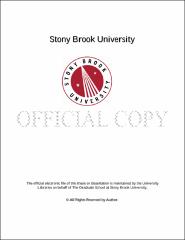| dc.identifier.uri | http://hdl.handle.net/11401/76912 | |
| dc.description.sponsorship | This work is sponsored by the Stony Brook University Graduate School in compliance with the requirements for completion of degree. | en_US |
| dc.format | Monograph | |
| dc.format.medium | Electronic Resource | en_US |
| dc.language.iso | en_US | |
| dc.publisher | The Graduate School, Stony Brook University: Stony Brook, NY. | |
| dc.type | Thesis | |
| dcterms.abstract | Fluorescent proteins are widely used in cell biology as molecular probes to observe a protein of interests location and movement and also to study protein-protein interactions. The study of protein-protein interactions is observed using a technique called fluorescent resonance energy transfer (FRET). FRET is used as a way to approximate distances between proteins in vivo and requires at least two fluorescent proteins in order to utilize the process. The most popular pairing is enhanced cyan and yellow fluorescent (eCFP/eYFP) proteins. To view protein localization, fluorescent proteins are attached to the protein of interest. PSD-95, a scaffolding protein in the post synaptic density of neurons has been studied with the use of fluorescent protein tags. PSD-95 is made up of three PDZ domains attached to an SH3 and GK domain by an intrinsically disordered linker. Specific interactions between the SH3 and GK domain must occur for PSD-95 to fold properly. This study has two objectives. The first objective is to create an in vivo FRET fluorescent protein reference ruler. To accomplish this, a series of eCFP/eYFP tandems were created with three different linker lengths to characterize their FRET interactions in vitro and in vivo. The results show that in vitro measurements are 4 times larger than in vivo measurements, however, they follow a similar trend. The second objective of this study sets out to see if folding the SH3-GK domain of PSD-95 is altered by the addition of a C-terminal fluorescent protein tag and to see how the fluorescent protein localize relative to PSD-95. A construct containing the SH3-GK of PSD-95 attached to eYFP by a 5 residue linker was created with cysteine labeling sites to observe intramolecular interactions between the SH3 and GK domains and intermolecular interactions between the SH3-GK domain and eYFP. Interactions were characterized using smFRET and compared to previously reported data of the SH3-GK domain in the absence of eYFP. Results suggest that eYFP does not affect the folding of the SH3-GK domain of PSD-95. | |
| dcterms.available | 2017-09-20T16:51:26Z | |
| dcterms.contributor | Bowen, Mark | en_US |
| dcterms.contributor | Scarlata, Suzanne | en_US |
| dcterms.creator | Dougherty, Laura Elizabeth | |
| dcterms.dateAccepted | 2017-09-20T16:51:26Z | |
| dcterms.dateSubmitted | 2017-09-20T16:51:26Z | |
| dcterms.description | Department of Biochemistry and Cell Biology. | en_US |
| dcterms.extent | 36 pg. | en_US |
| dcterms.format | Application/PDF | en_US |
| dcterms.format | Monograph | |
| dcterms.identifier | http://hdl.handle.net/11401/76912 | |
| dcterms.issued | 2014-12-01 | |
| dcterms.language | en_US | |
| dcterms.provenance | Made available in DSpace on 2017-09-20T16:51:26Z (GMT). No. of bitstreams: 1
Dougherty_grad.sunysb_0771M_12178.pdf: 1410177 bytes, checksum: 0955d4362524028f3a60af2723feb126 (MD5)
Previous issue date: 1 | en |
| dcterms.publisher | The Graduate School, Stony Brook University: Stony Brook, NY. | |
| dcterms.subject | Biology | |
| dcterms.title | Validating the use of fluorescent proteins as molecular probes in vivo and in vitro | |
| dcterms.type | Thesis | |

